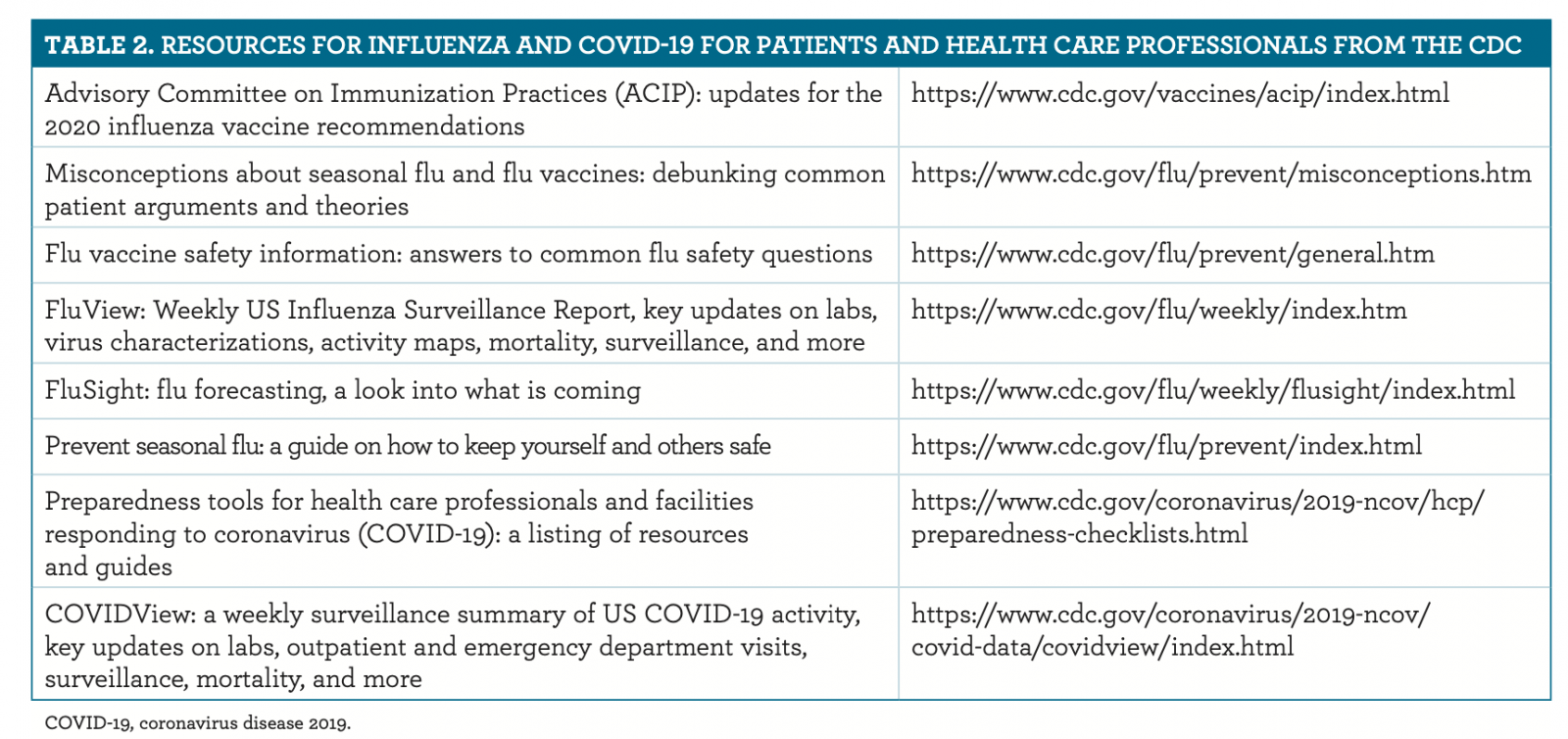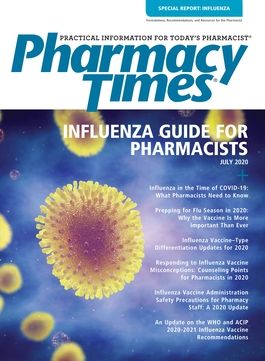Publication
Article
Supplements
Responding to Influenza Vaccine Misconceptions: Counseling Points for Pharmacists in 2020
Pharmacists will likely encounter increased demand for the influenza vaccine during the 2020-2021 flu season because of the widely recognized value of this preventive health measure, and the anticipated continued circulation of the severe acute respiratory syndrome coronavirus 2.
Pharmacists will likely encounter increased demand for the influenza vaccine during the 2020-2021 influenza season because of the widely recognized value of this preventive health measure and the anticipated continued circulation of the severe acute respiratory syndrome coronavirus 2 (SARS-CoV-2).1 This will contribute to an increased awareness of, and desire for, individuals to become immunized for protection, and allow providers to advocate immunization for those without contraindications to the available influenza vaccines.1,2 It is probable that the current global pandemic will result in new misperceptions and resurrect age-old questions that pharmacists should prepare to address, some of which will be explored next. The enhancement of vaccination rates in the United States may help to reduce the trajectory of illness and complications associated with influenza.
HOW TO PREPARE FOR CORRECTING MISCONCEPTIONS ABOUT COVID-19
The current outbreak of SARS-CoV-2 and its collateral effects are likely to persist into at least the fall, with health experts concerned over potential overlap with influenza or resurgence during peak influenza activity this upcoming winter.2,3 Pharmacists advocating influenza vaccination for preventive health should anticipate and be prepared for questions about the relationship between receiving the influenza vaccine and protection against coronavirus disease 2019 (COVID-19).4 Importantly, although there is much interest in the development of a vaccine against COVID- 19, it is worth explaining to patients that vaccination with the seasonal influenza vaccine will not confer protection against COVID-19.4 Similarly, a question raised during the 2019-2020 influenza season was whether receipt of the influenza vaccine would increase an individual’s chance of contracting COVID- 19. According to the CDC, there is no evidence that the influenza vaccine will increase susceptibility to SARS-CoV-2, and both of these issues should be addressed with education to allay concerns of the fearful patient.4 Reiterating the need to receive the influenza vaccine because of the potential risk of coinfection with COVID-19 during this upcoming season will be a critical education point, as concomitant infection with influenza and COVID-19 may be possible.2
Pharmacists are additionally likely to need to triage symptomatic patients, and help individuals discern symptoms of influenza from COVID-19, allergies, or other upper respiratory ailments (see “Influenza in the Time of COVID-19: What Pharmacists Need to Know” on page 4).2 The most common overlapping symptoms are common clinical manifestations of COVID-19 and seasonal influenza infection such as cough, fever, and shortness of breath.2 These symptoms may overlap and make differentiation based on symptoms difficult in the absence of testing.2 Finally, if there is a breakthrough in COVID-19 vaccine development, the vaccine’s availability should not interrupt the receipt of the seasonal influenza vaccine.5 It will be important for health care providers to reinforce the need for the influenza vaccine and ensure patients aren’t selectively choosing immunization with one vaccine over the other.
Other perennial influenza vaccine concerns and myths should also be anticipated, including addressing those individuals touting evidence of influenza viral illness after immunization or attributed to immunization with the influenza vaccine or those refuting the need for annual influenza vaccination due to perceived long-lasting protection.6 Strategies for addressing these common concerns and counseling points for educating patients on these and other common influenza vaccine misperceptions are included in table 1.6
FLATTENING THE CURVE
Although “flattening the curve” is a novel phrase coined during the current COVID-19 pandemic,7 administration of annual influenza vaccinations has been “flattening the curve” on influenza vaccine illnesses, medical visits, and hospitalizations for essentially as long as these vaccines have existed (figure).8 According to CDC mathematic modeling data from 2017 to 2018 on estimates of the burden of influenza illness in the United States, influenza vaccination during this time prevented 6.2 million illnesses, 3.2 million medical visits, 91,000 hospitalizations, and 5,700 deaths. This underscores not only the importance of this protective intervention on reducing the impact of influenza illness on the health care system but also how significant an impact influenza vaccination efforts have on public health.9
Regardless of what the upcoming fall and winter months will bring, circulation of SARS-CoV-2 has brought to light the importance of infection control measures—self-isolating when sick or symptomatic, maintaining social distancing, not touching one’s face, good hand hygiene practices, covering coughs and sneezes, and other infection control measures—and these are likely to persist for the foreseeable future.10 Furthermore, it is probable that these practices will have a mitigating effect on the spread of not only COVID-19, but on influenza and other viral illnesses as well.10 Practice-based resources to help pharmacists prepare to address concerns related to COVID-19 and influenza are included in table 2. It is critical that pharmacists continue to advocate for all possible behaviors to reduce illness. Influenza vaccination represents a critical aspect of that conversation.

REFERENCES
- Humer C, Steenhuysen J. Fears of coronavirus second wave prompt flu push at U.S. pharmacies, drugmakers. Reuters. May 26, 2020. Accessed June 3, 2020. https:// www.reuters.com/article/us-health-coronavirus-flu-focus/fears-of-coronavirus- second-wave-prompt-flu-push-at-u-s-pharmacies-drugmakers-idUSKBN2321F0
- Wu X, Cai Y, Huang X, et al. Co-infection with SARS-CoV-2 and influenza A virus in patient with pneumonia, China. Emerg Infect Dis. 2020;26(6):1324-1326. doi:10.3201/eid2606.200299
- Sun LH. CDC director warns second wave of coronavirus is likely to be even more devastating. The Washington Post. April 21, 2020. Accessed June 3, 2020. https://www.washingtonpost.com/health/2020/04/21/coronavirus-second- wave-cdcdirector/
- Key facts about seasonal flu vaccine. CDC. Updated April 28, 2020. Accessed June 3, 2020. https://www.cdc.gov/flu/prevent/keyfacts.htm#an- chor_1588163670473
- Seasonal influenza vaccine supply & distribution. CDC. Reviewed March 12, 2020. Accessed June 3, 2020. https://www.cdc.gov/flu/prevent/vaccine-sup- ply-distribution.htm
- Misconceptions about seasonal flu and flu vaccines. CDC. Updated September 25, 2019. Accessed June 3, 2020. https://www.cdc.gov/flu/prevent/misconcep- tions.htm
- Matrajt L, Leung T. Evaluating the effectiveness of social distancing interven- tions to delay or flatten the epidemic curve of coronavirus disease. Emerg Infect Dis. 2020;26(8). doi:10.3201/eid2608.201093
- Fong MW, Gao H, Wong JY, et al. Nonpharmaceutical measures for pandemic influenza in nonhealthcare settings—social distancing measures. Emerg Infect Dis. 2020;26(5):976-984. doi:10.3201/eid2605.190995
- 2017-2018 estimated influenza illnesses, medical visits, hospitalizations, and deaths and estimated influenza illnesses, medical visits, hospitalizations, and deaths averted by vaccination in the United States. CDC. Updated November 22, 2019. Accessed June 3, 2020. https://www.cdc.gov/flu/about/burden-avert- ed/2017-2018.htm
- How to protect yourself & others. CDC. Updated April 24, 2020. Accessed June 3, 2020. https://www.cdc.gov/coronavirus/2019-ncov/prevent-getting-sick/ prevention.html







